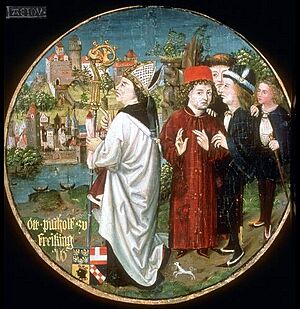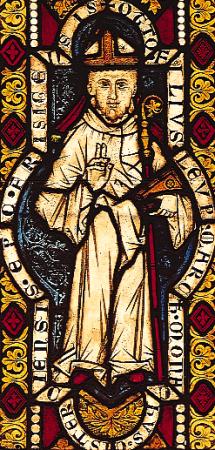Otto of Freising facts for kids
Otto of Freising (Latin: Otto Frisingensis; born around 1114 – died September 22, 1158) was an important German church leader. He was a member of the Cistercian order of monks. Otto wrote at least two books that give us valuable information about the history of his time. He became Otto I, the Bishop of Freising, in 1138. Otto also took part in the Second Crusade, a big religious journey. He survived the trip and reached Jerusalem. He later returned to Bavaria in the late 1140s and lived for another ten years back in Europe.
Contents
Otto's Life Story
Otto was born in Klosterneuburg. He was the fifth son of Leopold III, a powerful ruler of Austria. His mother was Agnes, who was the daughter of Emperor Henry IV. Agnes also had children from her first marriage. These included Conrad III, who became a German king. She was also the grandmother of Emperor Frederick I. Otto's sister, Judith, married a powerful leader named William V. This meant Otto was related to some of the most important families in Germany and northern Italy.
His Studies and Early Career
We don't have many records about Otto's early life. The exact dates are also a bit unclear. He studied in Paris, where he was especially interested in philosophy. People say he was one of the first to bring the ideas of Aristotle into Germany. He also served as a provost (a type of church leader) at a new religious place in Austria.
Becoming a Monk and Bishop
Otto joined the Cistercian order of monks. In 1133, he convinced his father to start Heiligenkreuz Abbey. This abbey helped bring reading and writing to the area that would become Vienna. It also brought advanced farming methods, including how to make wine. Around 1136, Otto became the abbot (head monk) of the Cistercian monastery of Morimond in Burgundy. Soon after, he was chosen to be the bishop of Freising.
At that time, the area of Freising and Bavaria was troubled. There was a big fight between two powerful families, the Welfs and the Hohenstaufen. The church was also in a bad state. But Otto, as the new bishop, made many improvements. He helped both the church and the local government.
The Second Crusade and Later Years
In 1147, Otto joined the Second Crusade. This crusade was very difficult and many soldiers died. The part of the army Otto was with suffered greatly. However, Otto managed to reach Jerusalem. He returned to Bavaria in 1148 or 1149.
He was well-liked by Conrad's successor, Emperor Frederick I. Otto likely helped solve a big disagreement about the duchy of Bavaria in 1156. He was also present at an important meeting called the diet of Besançon in 1157. Otto wrote that Frederick I brought a new time of peace after many years of fighting.
Otto continued to wear his Cistercian monk's robes. He died at Morimond on September 22, 1158. In 1857, a statue of Bishop Otto was put up in Freising, Bavaria.
Otto's Important Books
Otto is best known for two important historical books he wrote:
Chronicle of the Two Cities
His first major work is called Chronica sive Historia de duabus civitatibus. This means Chronicle or The History of the Two Cities. It is a historical and philosophical book with eight parts. It was partly inspired by the ideas of Augustine. Otto wrote this book during a time of civil war in Germany (1143–1145).
The book compares Jerusalem (the heavenly kingdom) and Babel (the earthly kingdom). It also contains a lot of valuable information about the history of Otto's own time. People at the time thought very highly of this chronicle. It covers events up until 1146. Another monk, Otto of St. Blasius, continued the story until 1209.
In the Chronica, Otto wrote about meeting a bishop named Hugh of Jabala. This bishop told him about a Christian king in the east named Prester John. People hoped this king would help the crusader states. This is the first time anyone wrote about Prester John.
The book also talks about a time of peace between emperors and church leaders. This happened after Rome became Christian. Rome was seen as the fourth and final great empire. After Rome, power went to the Greeks (Byzantines), then the Franks, and later the Germans. Otto also noted that Conrad III was the 93rd emperor after Augustus. Frederick I was the 94th.
However, Otto wrote that the Investiture Controversy broke this peace. This was when Pope Gregory VII unexpectedly removed Emperor Henry IV from the church in 1075. Otto believed this event started the seventh and last age of human history. He thought this period would be full of problems before the Antichrist arrived. This idea was discussed in the eighth and final part of his Chronicle.

Deeds of Emperor Frederick
Otto's other famous work is called Gesta Friderici imperatoris. This means Deeds of Emperor Frederick. Emperor Frederick I himself asked Otto to write this book. The book has four parts. Otto wrote the first two parts. His student, Ragewin (or Rahewin), wrote the remaining two parts. Some people think Otto might have written parts of the third and fourth books too.
The first part of the book starts with the argument between Pope Gregory VII and Emperor Henry IV. It then tells the story up to the death of Conrad III in 1152. This book is not just about German events. Otto also writes about the teachings of Bernard of Clairvaux. He mentions Bernard's strong feelings against heretics (people with different religious beliefs). He also talks about the ideas of Pierre Abélard. Otto also discusses philosophy and religion in this book.
The second part begins with the election of Frederick I in 1152. It describes the first five years of Frederick's rule in detail, especially in Italy. From 1156, Ragewin continued the work. Otto wrote in excellent Latin. Even though he favored the Hohenstaufen family a little, and had some small mistakes, his Gesta is seen as a "model of historical writing."
See also
 In Spanish: Otón de Frisinga para niños
In Spanish: Otón de Frisinga para niños


